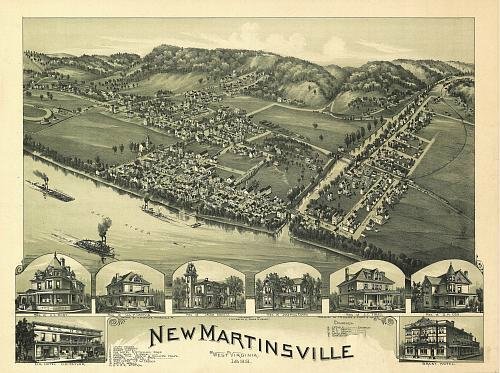| |
VIKING GLASS CO.: 1944-1970 PART 1 The new Martinsville Glass Manufacturing Co. was located in Martinsville, West Virginia. This company built a glass factory in 1900 mainly due to the discovery of natural gas in the area. By August 1900 the glass factory was up and running but shortly after a fire would destroy the factory. The company rebuilt a new factory but once again a tragedy would strike when the Ohio River flooded the factory and fire broke out again along with large explosions. This time the flooding would hamper the fire department from intervening. The glass factory would build again for the third time.  . Photo of New Martinsville by the Ohio
River. . Photo of New Martinsville by the Ohio
River. .Photo of the New Martinsville
Glasshouse. .Photo of the New Martinsville
Glasshouse.The company was producing tumblers, goblets, tableware, lamps, ink wells along with other fine glass items. At the time the Martinsville Glass co. was well known for its crystal figurines. The Martinsville Glass Co. continued producing glass items until the company went broke during the depression in the late 1930s. In 1938 the company was sold to people associated with the Silver Glass Company of Meriden, Connecticut. The company would reopen with the same name for a short time. In 1944 the Viking Glass Company would be formed. With the new company being formed in 1944, also came a full scale advertising campaign. The advertising took place in the China & Glass Trade Journal. These ads were specifying "Handmade in America" "For use in America Homes". In the 1940s crystal glass would dominated the production. In 1951 the Viking Glass Co. added in addition to crystal, evergreen, amber, eboney, cobalt blue, sky blue and ruby colors. By 1953 the company employed 200 people producing handmade tableware, smoker's supplies, novelties along with private mold work. By 1953 the new colors added were amethyst, charcoal, cherry glo, colonial blue harvest gold and olive green. By 1956 the new colors were amethyst mist, blue mist, cherry pink, emerald green, glamour gold, glamour green, gray mist, charcoal satinized and midnight eboney satinized. By 1964 the color choices dropped down to seven colors. amberina, avocado, green, bluenique, crystal, honey, persimmon and ruby. The color choices stayed the same until one new color was added in 1968. The color was thistle. By 1969 amberina and thistle was discontinued and lime green was added. By 1970 the color were avocado green, bluenique, brown, crystal, charcoal, cobalt, honey, lime persimmon and ruby. From the 1950s to the 1970s the most popular colors were avocado and amber.  .Viking post card from
1970. .Viking post card from
1970.Below is just a few of the many Viking Glass pieces produced.  .Crackle Ash Tray in green and a
Crackle Ask Try in amethyst. .Crackle Ash Tray in green and a
Crackle Ask Try in amethyst. .Sphere Ash Tray in persimmon and a Ash Tray in green. .Sphere Ash Tray in persimmon and a Ash Tray in green. .Epic crimped-bonbon in
amethyst. .Epic crimped-bonbon in
amethyst. .Epic six petel swung
vase 16" in bluenigue and a Epic six petel bub vase 17 3/4" in
persimmon. .Epic six petel swung
vase 16" in bluenigue and a Epic six petel bub vase 17 3/4" in
persimmon. .Epic swung bud vase 10
1/4" in amber and a Epic swung bud vase 20" in green. .Epic swung bud vase 10
1/4" in amber and a Epic swung bud vase 20" in green. .Three Full swung vase 29 1/2" in
persimmon. .Three Full swung vase 29 1/2" in
persimmon. .Epic 3 Foil swung vase 20"
in amethyst. .Epic 3 Foil swung vase 20"
in amethyst.In most cases Viking used paper labels only. Most of the labels on their glass is now long gone. There is still quite a bit of Viking Glass in antique store, flea markets, thrift stores.  .Paper Label. .Paper Label.For more information about Viking Glass you need to purchase a copy of Viking Glass 1944-1970 by Dean Six.  .
This is a 160 page paperback
book I call the Viking
Glass bible. .
This is a 160 page paperback
book I call the Viking
Glass bible.References: Viking Glass 1944-1970 by Dean Six. Frank & Cheryl (Wicker) Vase Collection. |
|---|---|